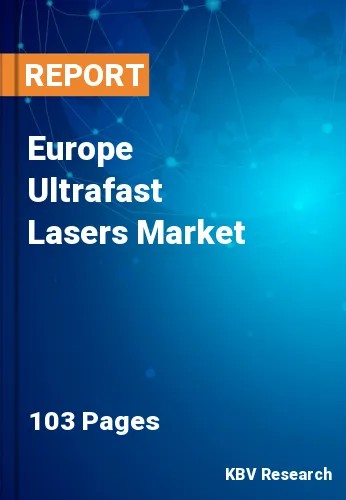The Europe Ultrafast Lasers Market would witness market growth of 14.5% CAGR during the forecast period (2022-2028).
Frequency mixing produces a signal that is a higher harmonic or the sum frequency of the first two by superimposing two beams with equal or differing wavelengths. In a non-linear crystal, parametric amplification occurs when a weak probe beam is overlapped with a higher energy pump beam. As a result, the weak beam is amplified and the residual energy is released as a new beam termed the idler.
With this method, output pulses can be produced that are shorter than input pulses. Different plans using this strategy have been put into practice. Examples include a non-collinear parametric amplifier, an optical parametric amplifier, and an optical parametric oscillator (NOPA). This approach is characteristic of "pump-probe" investigations, in which a pulsed laser is used to transition a material's electrons from their ground states to greater excitons.
Materials like molecules or semiconducting solids can be excited in this way. An absorption spectrum of the chemical is obtained at different periods after its stimulation using a probing light source, commonly a xenon arc lamp or bandwidth laser pulse produced by supercontinuum generation. The molecules are further excited to even higher orbitals as they absorb the probe light, or they are forced to radiatively return to the ground state by stimulated emission.
The UK business and government founded the Aerospace Growth Partnership (AGP), which develops programs to encourage close company cooperation, address industry gaps, and difficulties, remove growth-impeding barriers, and boost UK exports and high-value jobs. To align aircraft wings during manufacture, laser trackers are extensively used in the aerospace and aircraft industries. As a result, throughout the projected period, there would be an increase in demand for ultrafast lasers throughout this region.
The Germany market dominated the Europe Ultrafast Lasers Market by Country in 2021, and would continue to be a dominant market till 2028; thereby, achieving a market value of $234 million by 2028. The UK market is anticipated to grow at a CAGR of 13.6% during (2022 - 2028). Additionally, The France market would exhibit a CAGR of 15.3% during (2022 - 2028).
Based on Pulse Duration, the market is segmented into Femtosecond and Picosecond. Based on End User, the market is segmented into Medical, Industrial, Consumer Electronics, Automotive, Aerospace & Defense, and Others. Based on Type, the market is segmented into Fiber Lasers, Mode-Locked Lasers, Titanium-Sapphire Lasers, and Others. Based on Application, the market is segmented into Micromachining, Scientific Research, Medical Device Fabrication, Cardiovascular Stent Manufacturing, Bio-Imaging, and Others. Based on countries, the market is segmented into Germany, UK, France, Russia, Spain, Italy, and Rest of Europe.
Free Valuable Insights: The Global Ultrafast Lasers Market is Predict to reach $3.7 Billion by 2028, at a CAGR of 15.3%
The market research report covers the analysis of key stake holders of the market. Key companies profiled in the report include Lumentum Holdings, Inc., NKT Photonics A/S (NKT A/S), TRUMPF GmbH + Co. KG, Coherent, Inc.(II-VI Incorporated), IMRA America, Inc. (Aisin Corporation), Amplitude Systemes, Clark-MXR, Inc., DPSS Lasers Inc., and Wuhan Huaray Precision Laser Co., Ltd.
By Pulse Duration
By End User
By Type
By Application
By Country
Our team of dedicated experts can provide you with attractive expansion opportunities for your business.

